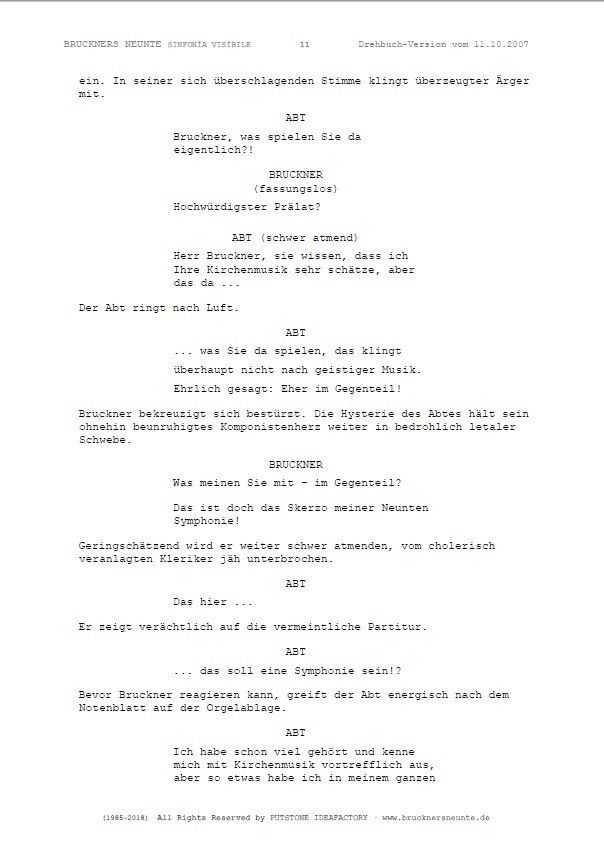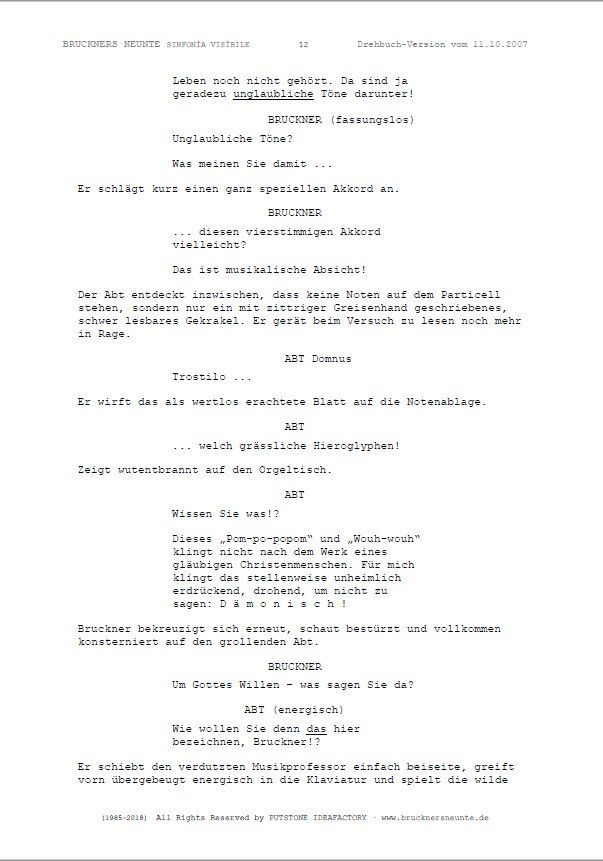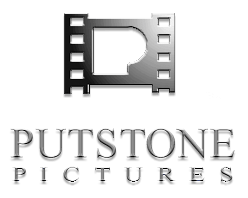1986 . Screenplay

Scene from the screenplay
... The elderly church musician Anton Bruckner, and undoubtedly the best organist of his time, played his Ninth Symphony for the first time in the St. Florian Abbey Church, together with an imaginary symphony orchestra, shortly before his death, exactly as he had originally envisioned it.
There, this pious "musician of God," as he was widely known, wasHe is prevented from continuing to play by an overzealous cleric who believes he hears demonic sounds in his symphony...
How it all began
The Symphony No. 9 in D minor (WAB 109) is Anton Bruckner's last. Bruckner fully completed three movements of the Ninth; the fourth movement remained unfinished.
The Linz-born pianist, conductor and music writer August Göllerich (1859 - 1923)
I knew Anton Bruckner personally and, as his biographer, compiled a wealth of interesting information about Bruckner, which, along with the archive of the Anton Bruckner Private University for Music, Drama and Dance (ABPU) in the Urfahr district of Linz, brought me closer to Bruckner's life and work. Göllerich's authentic, contemporary accounts are invaluable for my visual interpretation of Bruckner's final days; however, they reveal little about the background to the creation of the crucial final movement of the Ninth Symphony, which is essential to my project. According to Göllerich, Bruckner continued to improvise the final movement at the piano until his death, but was unable to commit the coda to writing in its final form.
UNFINISHED versus UNFINISHABLE
This is the interpretation of a contemporary shaped by the Pope's jurisdictional primacy, a figure who, like Bruckner, was profoundly influenced by the Church's all-encompassing power. Believing biographers from this era can take advantage of the fact that their observations, insights, and statements on this matter cannot be refuted in retrospect. His still-acclaimed Bruckner biography would likely never have been published had he described the mystical events surrounding the final movement of the Ninth Symphony—visible and audible to all—not as "unfinished," as Beethoven's Symphony No. 7 in B minor, D 759, but as Bruckner himself did, "by the grace of God unfinished." Thus, despite contradictory sketches and contemporary accounts, the Ninth Symphony entered music history as "Bruckner's Unfinished"—and not, as the maestro had consciously intended, as the equivalent of God's "unfinished" creation!
Recent biographical documents suggest that Bruckner was familiar with Darwin's theory of evolution, which sharply contradicts the creation story, and incorporated it into his music, but struggled with his impending death due to the Catholic Church's imposed rejection of it. How could he reconcile his last symphony, in the sense of a closed, divine creationism, with the ultimately open-ended evolution of those who thought differently? Therefore, he placed his hopes on the more open-minded understanding of future generations and ultimately concluded a conciliatory agreement with God, which is documented verbatim: "If God wants me to finish my last symphony, which is meant to be a hymn of praise to God's creation, then he must grant me life for that long, because if I die earlier, then God himself will have only himself to blame if he receives an unfinished work.!"
In this context, I raise the question: Did Bruckner actually say "unfinished" and not "unfinishable" work, or did the Catholic biographer have to interpret and record it that way? Religious matters, after all, pertain to areas that are not empirically verifiable. Furthermore, Bruckner was not yet familiar with the theory of evolution...
This explicitly concerns phenomena automatically attributed to Bruckner, such as his supposedly exclusive, God-centered spirituality, which are, however, accessible only to subjective experience. For non-believers, these phenomena are neither explainable nor objectively measurable, and therefore, a purely rational, scientific approach cannot yield any generally conclusive statement about their truth. Unfortunately, biographies written from such an almost irrational standpoint in the 19th century have found their way into our beliefs and repertoire of common knowledge.
This isn't about factual tradition, then; rather, a supernatural power seems to be at work. The beauty of music is thus a purely divine principle. When considering the artistic thought patterns attributable to Bruckner in this regard, I encounter limits to rational explanation, especially since his preoccupation with exploring death—something he desperately needed for his Ninth Symphony—led to attempts to declare him insane and commit him to an asylum! Thankfully, his friends and doctors were able to prevent this.
That makes my ears start to wither, as they say in Russia.
It is officially known that Bruckner's attending physician, Max Auer, reported in 1924 that the elderly composer was quite weak and despairing at the end of his life, and that Auer had therefore offered to write down the main ideas of the fourth movement of the Ninth Symphony for him. However, Bruckner—probably with good reason, as we now understand it—refused to do so and repeatedly stated that he hoped future generations would come to understand the open ending of the Ninth Symphony.
TREDICIMAL CHORD versus DISSONANCES
But let's stick with my interpretation of BRUCKNER'S NINTH: Admittedly, what might be the fluctuating thirteenth chord at the zenith of the Adagio in BRUCKNER'S NINTH is for individual Brucknerians the immensely dramatic soundscape and the surprising, cinematic-seeming dissonances and stops in the preferred conglomerate of slow tempi and pauses.
After listening to many different recordings of Bruckner's Ninth Symphony by renowned conductors, from Furtwängler and Schuricht to Wand and Abbado, I came to the surprising conclusion that, in sum, they all reproduce a musically high-quality—or, if you will, musically correct—uniform sound of the Ninth. This was alarming to me, because during rehearsals of the Original Bruckner Orchestra, where, at our request, we were forced to play certain passages much slower than usual for practice, I had the unique opportunity to hear parts of this symphony at a tempo that evoked previously unknown sensations in myself and others.
THE NINTH IS THE FIRST SYMPHONY FILM SCREEN IN HISTORY
I am a filmmaker and not a Bruckner conductor, so I approached this last symphony by Bruckner at the Bruckner symposia with a rather naive attitude and completely different expectations than a full-blooded musician, critic or even musicologist.
After conversations with some of the orchestra musicians and audience members following a rehearsal, they apparently also shared the subjective feeling that the passages played very slowly, experimentally and precisely according to Bruckner's instructions, offered a different, much more pronounced listening experience in the Ninth Symphony than the passages that had been played far too hastily by all the conductors so far. I was deeply moved, because it was not without reason that Bruckner wrote so unequivocally about the score of the Ninth: "Please play very, very slowly!"
While everyone has different images in their mind when listening to a symphony, I had the emotional impression that Bruckner was telling me an extremely dramatic story with the musical means at his disposal – all that was missing were the corresponding metaphorical images or film scenes. No wonder, since Bruckner had always admired Wagner, who could compose his musical narratives directly for the stage – something he (still) couldn't do.
That was the final trigger for me to examine more closely Bruckner's sensitively hidden visionary notes, marginalia, dramaturgical hints and concrete musical instructions in the score, hidden between the staves of music.
Even without the increasingly visible details in drafts and sketches of Bruckner's three-movement score, a director immediately notices, upon closer listening, the unusually large number of blocks in the score for a symphony. As already mentioned, these blocks effectively correspond to individual film scenes – a particularly characteristic compositional feature that, to my knowledge, is found only in Bruckner's Ninth Symphony among 19th-century Romantic symphonies. These musical sections tell self-contained episodes, always with a clear beginning and occasionally with an unexpectedly abrupt end, reminiscent of sharp, dramatically placed cuts in film, or they end in so-called (general) pauses, thus creating extremely long flashbacks between the blocks/eras.
The cinematographic style, probably deliberately chosen by Bruckner*1 The structured sequences of his special NINTH SYMPHONY are, for me, clearly recognizable scene guidelines and have such unambiguous associative pivot points of the highest dramaturgy with structure, climax and conclusion that, if one knows how to interpret them correctly, they cannot be overlooked.
These classical elements of the narrative form, together with the all-dominating, highly dramatic leitmotif of divine creation and the consciously situated setting around Bruckner's birthplace and death site, together with the testimonies of the turbulent West, constitute, as it were, the story, the "libretto" of mysinfonìa visìbile in re minore regeneratione BrucknerThe only remaining task was to develop a dramaturgically and technically adequate counterpoint from these powerful "soundscapes" musically provided by Bruckner, in accordance with his vision. What a challenge!
Another important artistic inspiration for me was that, as early as the 1930s, the director Sergei Eisenstein created a consistent formal scheme for his film Aleksandr Nevsky to harmonize camera images with the score of the composer Sergei Prokofiev. But he, Eisenstein, could discuss it with Prokofiev—I, Legenstein, unfortunately could not with Bruckner.
For the culturally open-minded young mayor and the Original Bruckner Orchestra of Ansfelden, whom I was able to convince of my project after some initial, understandable skepticism, I developed the following initial plan for the open-air world premiere on the 100th anniversary of Bruckner's death. The performance was to be shown on a large screen in the middle of the generously sized green space in front of the motorway church in Haid/Ansfelden. Since I was also the director of Ansfelden's local television station at the time, nothing seemed to stand in the way of this spectacular project commemorating Ansfelden's elevation to city status.
But the extremely slow approval processes ultimately caused the planned spectacular premiere to fail. Too many bureaucratic and stubborn cooks inevitably spoil even the best-prepared artistic endeavor.three, which I have experienced in the subsequent (currently almost 40!) years of implementing my sinfonìa visìbile in re minore regeneratione Bruckner had to learn this the hard way time and time again.
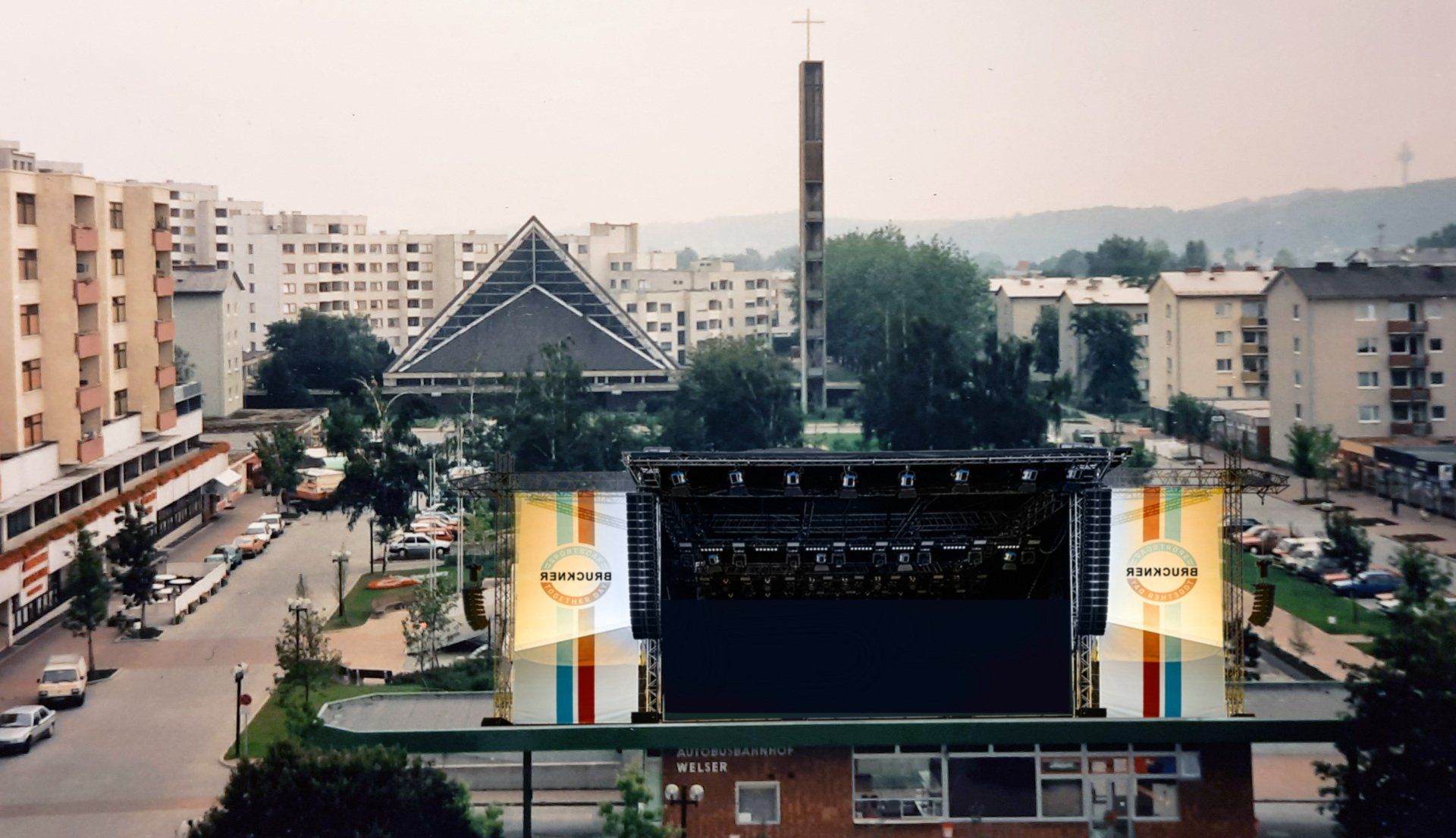
Town square in Haid/Ansfelden
__________
*1Bruckner was familiar with the medium of film: The Cinématographe, the world's first functioning film camera, was patented by Thomas Alva Edison in the USA in 1894. Even during Bruckner's lifetime, short films were publicly screened in Europe (Paris, Berlin) using the Cinématographe invented by the Lumière brothers or the crank-operated film camera (Bioscop) developed by the Skladonowski brothers. Bruckner expressed his enthusiasm for the first "moving pictures" shown at Munich markets.
Cooperation plans with the best of the best

None other than the renowned German opera singer Rudolf Schock, with whose son-in-law Johny Müller I had founded a film production company in Starnberg near Munich, was the invaluable intermediary to the conductor Herbert von Karajan. At that time, Karajan had what was probably the most advanced recording studio in the world in a chapel on his estate in Salzburg. State-of-the-art digital high-tech equipment, installed by Sony CEO and founder Akio Morita himself.
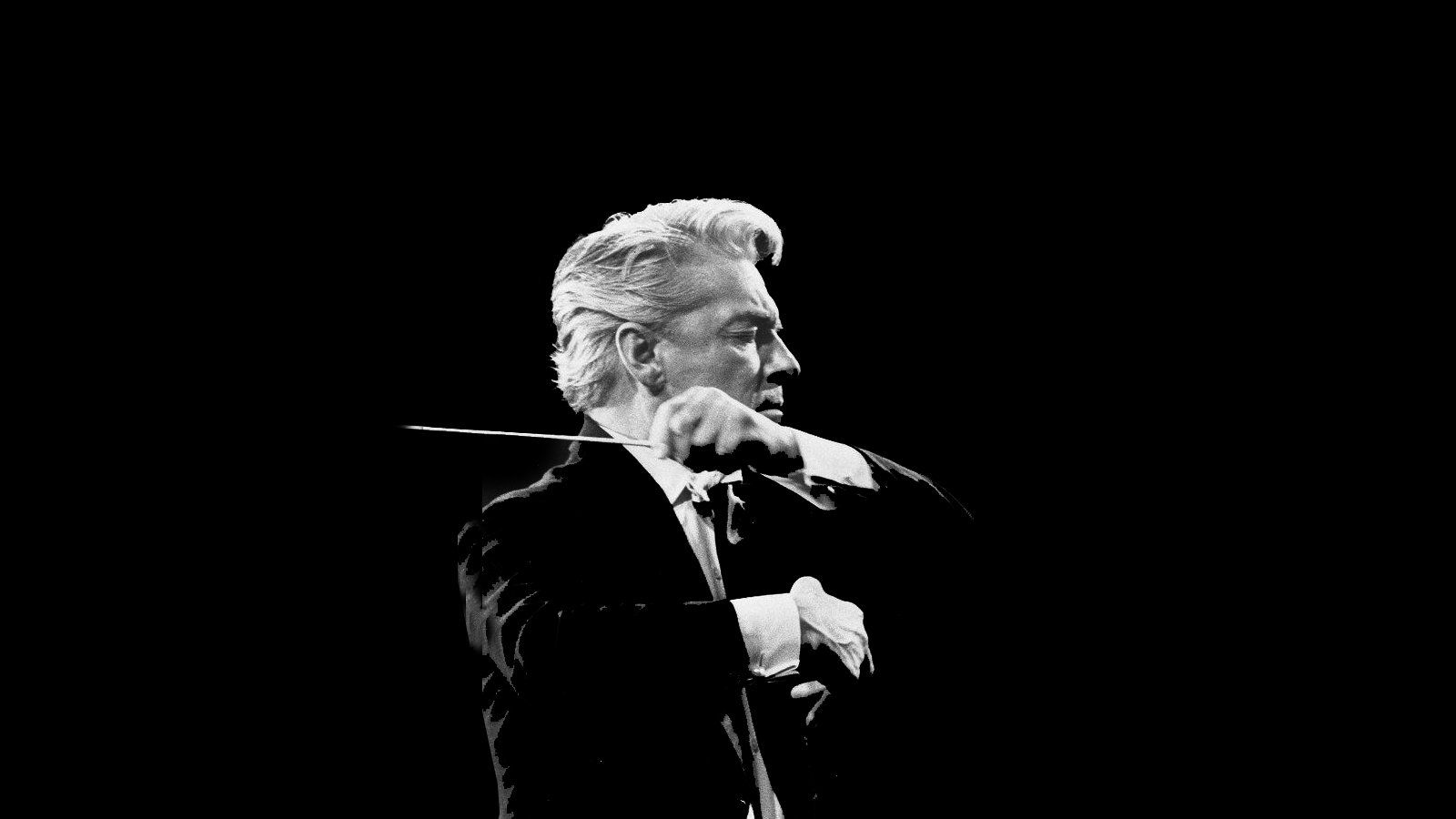
At first, everything fell into place like a beautiful dream.
Karajan was experimenting with new digital technologies at the time and was therefore the ideal musical partner, as God had done, for realizing my ambitious plans.
BRUCKNER'S NINTH sinfonìa visìbile in re minore regeneratione Bruckner.
I didn't have to explain my visual intention to Karajan for long, because he was in the thick of it, especially since he was recording a digital exclusive (DDD) recording of Bruckner's Symphony No. 7 in E major (the Romantic) with the Vienna Philharmonic, which is still considered one of the best interpretations of this Bruckner work.
I could hardly believe my luck:
Next up was the Ninth - the course was set!
But as cruel as fate sometimes is to us creatives, unfortunately no final collaboration came about, because my patron, Kammersänger Rudolf Schock, died unexpectedly in the same year, and Herbert von Karajan only about two and a half years later.
A shock – because there I stood in front of the open gate and was as far along as before...
But that wasn't all, because an incident from this period would later significantly hinder the project's progress: What I, as the director, always criticized about Karajan's digital recordings—and what I found Karajan himself, while highly peculiar, interesting—was, of course, not the music or his famous conducting, but the video recordings made during them—which I considered outdated, I believe I said unprofessional. No one in his illustrious sphere of influence could understand how I could dare to criticize the maestro's visual work! But, as I said, my concern wasn't with Karajan's musical work, which, of course, was not my place to judge, but with a perfect visualization of Bruckner's Ninth Symphony, which I saw as utterly lacking in the profane execution by his film crew.
And so my artistic dream, which I had just built, the sensational collaboration with the best possible partner and his musicians, mercilessly vanished into thin air. Understandably, I fell into a deep emotional abyss. Aside from the loss of invaluable contacts, I now had to find the right musical realization for my project all over again. sinfonìa visìbile To worry. Where, pray tell, was the conductor who could replace the brilliant Karajan?
I only had about seven years left (until October 11, 1996) to do it.

